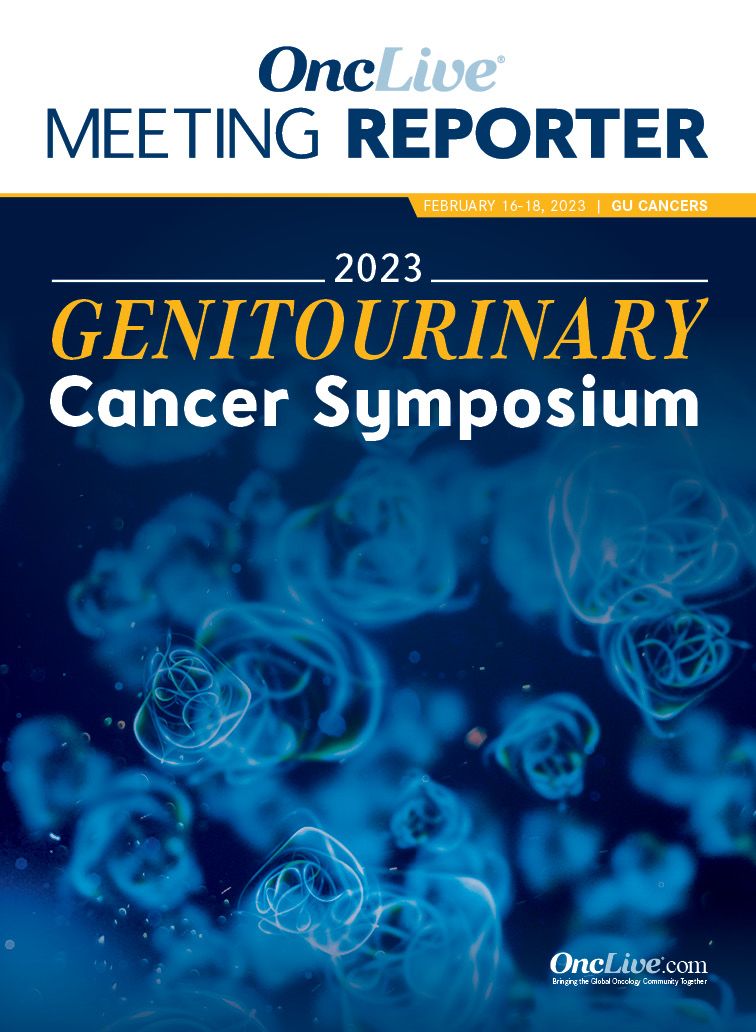Publication
Article
Cabozantinib Plus Atezolizumab Produces Durable Responses in Non–Clear Cell RCC
Author(s):
The combination of cabozantinib and atezolizumab elicited responses in patients with non–clear cell renal cell carcinoma, according to extended follow-up data from the phase 1b COSMIC-021 trial.
Bradley A. McGregor, MD

The combination of cabozantinib (Cabometyx) and atezolizumab (Tecentriq) elicited responses in patients with non–clear cell renal cell carcinoma (RCC), according to extended follow-up data from the phase 1b COSMIC-021 trial (NCT03170960) presented at the 2023 Genitourinary Cancers Symposium.1
At a median follow-up of 37.2 months (range, 32.1-58.5), patients treated with cabozantinib plus atezolizumab (n = 32) achieved an objective response rate (ORR) of 31% (95% CI, 16.1%-50.0%). All responders experienced a partial response (PR), and the rates of stable disease and progressive disease were 63% and 6%, respectively. The disease control rate (DCR) was 94% (95% CI, 79.2%-99.2%), the median time to response was 2.7 months (range, 1.2-6.9), and the median duration of response (DOR) was 8.1 months (95% CI, 2.4-18.1).
“We observed an ORR that was comparable to what we’ve seen previously with the updated analysis,” Bradley McGregor, MD, explained in an interview with OncLive®. “What is impressive with 3-plus years of follow-up is that there is no new toxicity signals at this time, and 5 patients remain on therapy.”
McGregor is a senior physician and the clinical director of the Lank Center for Genitourinary Oncology at Dana-Farber Cancer Institute and an instructor in medicine at Harvard Medical School in Boston, Massachusetts.
COSMIC-021 is a multinational phase 1b study examining the combination of cabozantinib plus atezolizumab in patients with advanced solid tumors. Previously reported data at a median follow-up of 13.3 months showed that the combination demonstrated encouraging clinical activity in patients with non–clear cell RCC. The ORR among 32 patients was 31% (80% CI, 20%-44%), with all responders achieving a PR.2
The non–clear cell RCC expansion cohort enrolled patients with measurable disease per RECIST v1.1 criteria with a non–clear cell component, including those with a sarcomatoid component. Patients were allowed to have prior treatment with up to 1 VEGFR-targeting TKI for inoperable locally advanced, recurrent, or metastatic disease.1 Prior treatment with MET-targeted TKIs or any immune checkpoint inhibitor was not permitted.
Enrolled patients in the non–clear cell RCC expansion cohort (n = 30) received 40 mg of oral cabozantinib daily and 1200 mg of intravenous atezolizumab once every 3 weeks. The efficacy- and safety-evaluable populations included 2 patients from the dose-escalation portion of the trial.
To manage adverse effects (AEs), cabozantinib could be held or reduced from 40 mg per day to 20 mg per day, or from 20 mg per day to 20 mg every 2 days. Atezolizumab infusions could also be delayed. Treatment was continued if patients continued to experience clinical benefit or until unacceptable toxicity.
Tumor assessment per RECIST v1.1 criteria was conducted by investigators every 6 weeks during the first year and every 12 weeks thereafter. The primary end point of the trial was investigator-assessed ORR per RECIST v1.1 criteria. Safety was a secondary end point. Exploratory end points included DOR, progression-free survival (PFS), and overall survival (OS).
The median age of the 32 evaluated patients was 62 years (range, 37-78). Eighty-one percent of patients were male, and 72% were White. Patients had an ECOG performance status of either 0 (75%) or 1 (25%). International Metastatic RCC Database Consortium (IMDC) risk groups included favorable (38%), intermediate (47%), and poor (16%).
Histology subtypes included papillary (47%), chromophobe (28%), clear cell (3%), and other (22%). Notably, the one patient enrolled with clear cell histology was a deviation from study protocol. Thirteen percent of patients had a sarcomatoid component. Thirteen percent of patients had a PD-L1 combined positive score (CPS) of at least 1 %, and 56% had a PD-L1 CPS of less than 1%. PD-L1 status was unknown in 31% of patients.
The number of tumor sites included 1 (16%), 2 (28%), and 3 or more (56%). Metastatic lesion sites included lymph node (59%), lung (50%), kidney (25%), liver (16%), bone (16%), adrenal (9%), and other (9%). Eighty-one percent of patients had no prior lines of systemic therapy, and 19% had 1 prior line of systemic therapy. Additionally, 19% of patients received a prior VEGF-targeting TKI, and 1 patient was previously given a VEGFR TKI and an mTOR inhibitor. Additionally, 6% of patients had prior radiotherapy, and 63% underwent total nephrectomy.
Additional data showed that patients with favorable-risk disease (n = 12) experienced an ORR of 42% (95% CI, 15.2%-72.3%), a DCR of 100% (95% CI, 73.5%-100%), and a median DOR of 8.3 months (95% CI, 4.2-not estimable [NE]). Those with intermediate- or poor-risk disease (n = 20) had an ORR of 25% (95% CI, 8.7%-49.1%), a DCR of 90% (95% CI, 68.3%-98.8%), and a median DOR of 7.9 months (95% CI, 2.4-NE).
Among patients with papillary histology (n = 15), the ORR was 47% (95% CI, 21.3%-73.4%) with a DCR of 93% (95% CI, 68.1%-99.8%) and median DOR of 13.7 months (2.4-21.6). Those with chromophobe histology (n = 9) had an ORR of 11% (95% CI, 0.3%-48.2%) with a DCR of 89% (95% CI, 51.8%-99.7%) and a median DOR of 5.6 months (95% CI, NE-NE). In patients with other histology (n = 7), the ORR was 14% (95% CI, 0.4%-57.9%) with a DCR of 100% (95% CI, 59.0%-100%) and a median DOR of 7.9 months (95% CI, NE-NE).
Patients who had a total nephrectomy (n = 20) experienced an ORR of 20% (95% CI, 5.7%-43.7%), a DCR of 90% (95% CI, 68.3%-98.8%), and a median DOR of 6.9 months (95% CI, 4.2-NE). Patients who did not have a total nephrectomy (n = 12) achieved an ORR of 50% (95% CI, 21.1%-78.9%) with a DCR of 100% (95% CI, 73.5%-100%) and a median DOR of 10.8 months (95% CI, 2.4-NE).
Overall, 81% of patients experienced a reduction in tumor lesions. The median OS was NE (95% CI, 23.0 months-NE). The estimated 12-, 24-, and 36-month OS rates were 84% (95% CI, 66%-93%), 70% (95% CI, 50%-83%), and 54% (95% CI, 34%-71%), respectively. The median PFS was 9.3 months (95% CI, 5.5-12.3), the estimated 12-month PFS rate was 34% (95% CI, 18%-50%), and the estimated 24-month PFS rate was 6% (95% CI, 1%-24%).
Among patients with favorable-risk disease, the median PFS was 10.9 months (95% CI, 6.7-19.4) and the median OS was NE (95% CI, 31.8-NE). Those with intermediate- or poor-risk disease experienced a median PFS of 6.5 months (95% CI, 2.7-12.3) and a median OS of 24.3 months (95% CI, 6.1-NE).
For patients with chromophobe, papillary, or other histology, the median PFS was 10.8 months (95% CI, 1.4-19.4), 8.1 months (95% CI, 2.7-18.4), and 6.3 months (95% CI, 2.7-NE), respectively. The median OS among those groups was NE (95% CI, 2.2-NE), 31.8 months (95% CI, 6.1-NE), and 26.9 months (95% CI, 3.4-NE), respectively.
Patients who had a total nephrectomy experienced a median PFS and OS of 6.8 months (95% CI, 2.7-10.9) and NE (95% CI, 22.7-NE), respectively. Those who did not have a total nephrectomy had a median PFS and OS of 10.6 months (95% CI, 3.4-22.1) and 29.0 months (95% CI, 14.5-NE), respectively.
At the July 21, 2022, data cutoff, 16% of patients remained on study treatment. Nine percent of patients were still receiving both cabozantinib and atezolizumab, and 6% were receiving cabozantinib alone. The median duration of exposure was 16.6 months (range, 0.8-36.4) for the combination of cabozantinib and atezolizumab. The median duration of exposure for cabozantinib was 12.7 months (range, 0.8-36.4), and the median duration of exposure for atezolizumab was 11.9 months (range, 0.0-34.6).
Fifty percent of patients experienced AEs leading to cabozantinib dose reduction, 91% had AEs leading to cabozantinib dose holds, and 44% had AEs leading to atezolizumab dose delays. Thirty-eight percent of patients discontinued either agent due to treatment-related AEs (TRAEs). The rates of discontinuation due to TRAEs for cabozantinib, atezolizumab, and both agents were 31%, 22%, and 13%, respectively.
Ninety-seven percent of patients experienced at least 1 any-grade TRAE, and 53% had grade 3/4 TRAEs. The most common TRAEs occurring in at least 20% of patients included diarrhea (any grade, 69%; grade 3/4, 6%), palmar-plantar erythrodysesthesia (PPE; 50%; 3%), fatigue (44%; 0%), dysgeusia (41%; 0%), hypertension (31%; 22%), nausea (31%; 3%), weight decrease (25%; 0%), amylase increase (22%; 6%), and aspartate aminotransferase (AST) increase (22%; 0%). One patient experienced a grade 5 TRAE (pulmonary hemorrhage).
Any-grade AEs of special interest were reported in 84% of patients, and 41% had grade 3/4 AEs of special interest. AEs of special interest occurring in at least 5% of patients included PPE (any grade, 56%; grade 3/4, 3%), amylase increase (25%; 9%, AST increase (22%; 0%), lipase increase (19%; 13%), alanine aminotransferase increase (13%; 6%), ascites (9%; 3%), dermatitis acneiform (9%; 0%), hyperthyroidism (9%; 3%), rash (9%; 0%), gamma-glutamyltransferase increase (6%; 3%), pneumonitis (6%; 3%), and transaminase increase (6%; 0%).
“There were no new safety signals, that is to be expected with extended profile, as there wasn’t a new toxicity profile that was elucidated. It remains a well-tolerated regimen with toxicity that would be expected,” McGregor noted.
The ongoing phase 3 CONTACT-03 trial (NCT04338269 is evaluating cabozantinib plus atezolizumab vs cabozantinib alone in patients with non–clear cell RCC and clear cell RCC who received prior treatment with an immune checkpoint inhibitor.
“[CONTACT-03] is one of the first trials including clear cell, as well as papillary RCC, given what we saw here [in COSMIC-021]. [Patients with] papillary disease had responses comparable with what we [saw] with clear cell RCC,” McGregor concluded.
References
- McGregor B, Agarwal N, Suarez C, et al. Cabozantinib in combination with atezolizumab in non-clear cell renal cell carcinoma: extended follow-up results of cohort 10 of the COSMIC-021 study. J Clin Oncol. 2023;41(suppl 6):684. doi:10.1200/JCO.2023.41.6_suppl.684
- Pal SK, McGregor B, Suarez C, et al. Cabozantinib in combination with atezolizumab for advanced renal cell carcinoma: results from the COSMIC-021 study. J Clin Oncol. 2021;39(33):3725-3736. doi:10.1200/JCO.21.00939










